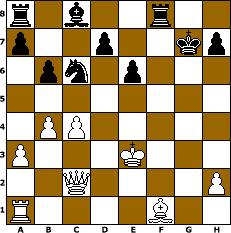In chess, a combination is a relatively long sequence of moves, often initiated by a sacrifice, which leaves the opponent few options and results in tangible gain. At most points in a chess game, each player has several reasonable options from which to choose, which makes it difficult to plan ahead except in strategic terms. Combinations, in contrast to the norm, are sufficiently forcing that one can calculate exactly how advantage will be achieved against any defense. Indeed, it is usually necessary to see several moves ahead in exact detail before launching a combination, or else the initial sacrifice would not be undertaken.
A combination is usually built out of more fundamental chess tactics such as forks, pins, skewers, undermining, discovered attacks, etc. Thus a combination must be at least three moves long, but the longer it takes to recoup the initial sacrifice, the more impressive the combination. The following example, from Stepanov-Romanovskij, Leningrad 1926, is a combination which illustrates several forks and skewers. (The moves are given in algebraic chess notation.)

Black played 1... Rf3+. White dare not take the rook with 2.Kxf3 because of the threatened royal fork 2...Nd4+, which would win the white queen. Retreating with 2.Ke2 instead would run into the same fork. The move 2.Kd2 looks more promising, but after 2...Rf2+ (skewering the white king and queen) 3.Be2 Rxe2+ 4.Kxe2 Nd4+ the white queen will be lost anyway. Therefore White was forced to play 2.Ke4.
The game continued 1... Rf3+ 2.Ke4 d5+, and White resigned. White still could not take the black rook without losing his queen, but the alternative 3.cxd5 exd5+ 4. Kxd5 Be6+ would leave White with no good defense. Taking the bishop with 5.Kxe6 allows the long-threatened fork 5...Nd4+, while taking the knight with 5.Kxc6 allows the skewer 5...Rc8+ followed by 6...Rxc2. Retreating with 5.Ke4 permits the black bishop to skewer the white king and queen with 5...Bf5+, so White has only one option left: 5.Kd6.
After the forced sequence 1... Rf3+ 2.Ke4 d5+ 3.cxd5 exd5+ 4. Kxd5 Be6+ 5.Kd6, Black would have played 5... Rd8+. White couldnīt take the bishop or the knight for exactly the same reasons as before (after 6. Kxe6 Nd4+ 7. Ke7, Black comes out a rook ahead with 7... Nxc2 8. Kxd8 Nxa1), which leaves one legal move, namely 6.Kc7, but then 6...Rf7+ absolutely forces the white king to take the black knight, allowing the skewer 7...Rc8+ followed by 8...Rxc2.
This beautiful combination is eight moves long, a depth to which precise calculation is normally impossible, except by computers.
The concept of combination in chess is similar that of boxing, wrestling and other martial arts.
|
